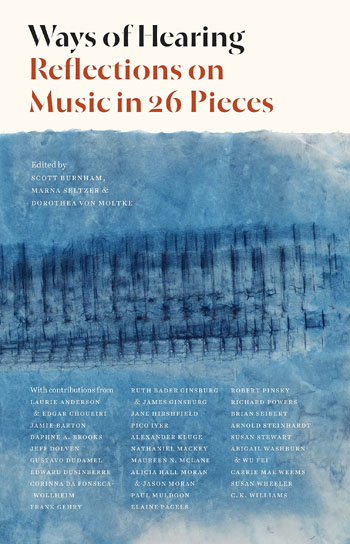|
WAYS
OF HEARING
Reflections on Music in 26 Pieces
Eds Scott Burnham, Marna Seltzer & Dorothea von Moltke
ISBN 978-0-691-20447-5
The best pieces in this book are by professional musicians, which is
predictable: take a person away from their expertise and they are an
idiot. Gustavo Dudamelís essay on Fidelio, for example, is a
little masterpiece. You would need to be well trained in music to
grasp its details, which is perhaps a problem in writing about
music. There is an entire industry devoted to writing about what is
associated with music, especially pop. You could fill a library with
books about The Beatles, but most of them have nothing to say
about music and are probably written by people who donít have the
skill. Most of the music discussed here is of the kind people listen
to rather than through. No one, presumably, ever played air cello.
The pop variety is a muddled form in which the music serves group
identification and narcissistic propping of unsure minds. To write
properly about music you need to know how it works, and few of us
do. When Dudamel writes that Beethoven had ďthe timpani tuned in
tritonesĒ only a minority will grasp what that means and its
implications. Yet itís precisely because, as a non-musicologist
reader, you realise you are in the company of an expert, that the
best writing here is so pleasing.
Perhaps the book is aimed at a musically sophisticated audience.
That would be a pity. Itís a fine thing to put highly skilled work
in front of a much less competent audience. The notion of pearls
before swine implies the majority can never be anything but swinish.
Like Dudamel, Edward Dusinberre carries his talent naturally.
Driving to a recording on a winterís morning, he listens to and
muses over Schubertís String Quartet: ďWhile the second cello
continues its pizzicato frame and the inner voices journey through
their chord changes, I am propelled to the second and fourth beats
of each bar by a simple dotted rhythm.Ē Most listeners, even to
serious music, probably pay most attention to their emotional
response, music having the advantage over language that it can go
straight to the emotions without having to be filtered by the
nuisance of semantics. To be made aware of the kind of listening an
expert musician engages, is an encouragement to find out more.
Jamie Barton impels in the same direction. She explains how
enraptured she was on first hearing Chopin and, tellingly, how
Claudio Arrauís interpretations seem to her most in keeping with the
composerís music. Thatís a good lesson in listening and thinking
carefully. Charmingly, she relates how a compilation CD, Chopin
and Champagne, changed her life. The title might seem cheap and
commercial but the artists certainly werenít: Arrau on all but one
track and the London Philharmonic. Perhaps thatís a good reminder of
how people can be inspired to a love of the arts in the most unusual
ways and how we should encourage whatever interest people show
without being judgemental.
Abigail Washburn and Wu Fei have in common both music and familial
similarities, not all of them positive. Their contribution is a
fascinating exploration of communication across cultural
differences. The identity they discover in two apparently
unconnected songs is a reminder of our common human inheritance, of
how little comes between us in spite of superficial distinctions.
Music, of course, is universal. Not in the same way as language
which is an inherited faculty present in all of us (barring fairly
severe damage). Not everyone is musical, but all cultures are and
there seems to be evidence for a more or less universal response to
music of certain kinds, even in people who canít hold a tune.
Arnold Steinhardt focuses on Beethovenís String Quartet in B flat.
Heís excellent on the nature of the string quartet as a form and
enlightening on details about his chosen one: how, for example, in
the Cavatina movement, a very unusual key change generates the acute
sense of someone who is ďbeklemmtĒ (anguished). He quotes Einstein
who said things must be kept as simple as possible, but no simpler.
Steinhardt sees that simplicity as the core of string quartet, a
true musicianís insight.
The least successful pieces are probably those from poets. Poetry
can be about anything of course, but in company with people who know
music inside out, the poets seem somewhat out of place. Paul Muldoon
contributes a piece on Elgar. The rara avis always was in fact quite
commonplace. In response to his famous question, it could be said
though the poem purports to be about Elgar, itís really about
Muldoon.
There are one or two references which might seem somewhat dubious.
Elaine Pagels writes of her love for Elvis, but perhaps youthful
indiscretions can be glossed over. Pico Iyer praises Leonard Cohen
whose songs are surely put in the shade by those of Georges Brassens
who Laurie Anderson and Edgar Choueiri wisely include amongst their
favourites.
Jeff Dolven makes a mistake in his piece, Work Song: it was
Baudelaire not Stendhal who said that beauty is the promise of
happiness; and there is an interesting reference to evolution and
mathematics in Alexander Klugeís essay on opera. The mathematical
faculty canít be an adaptation because the majority of people whoíve
walked the planet have never used it, but then nor can musical
ability but look what joy that brings.
|
